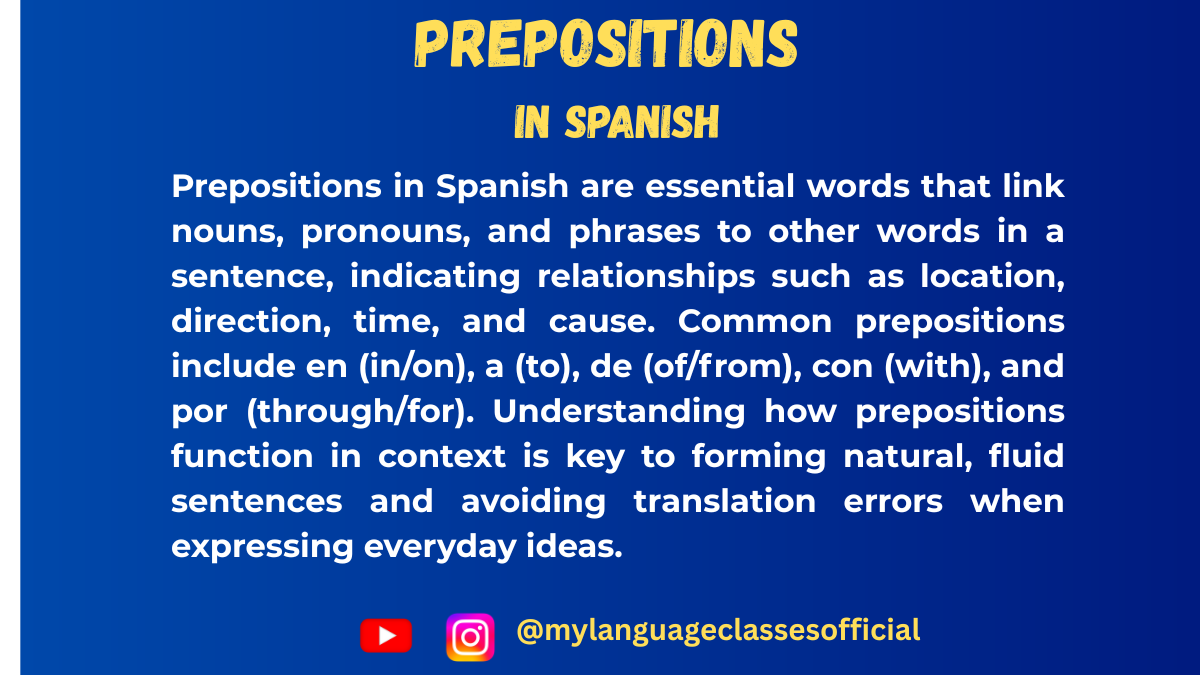Your cart is currently empty!
Tag: Learn Spanish Online
-
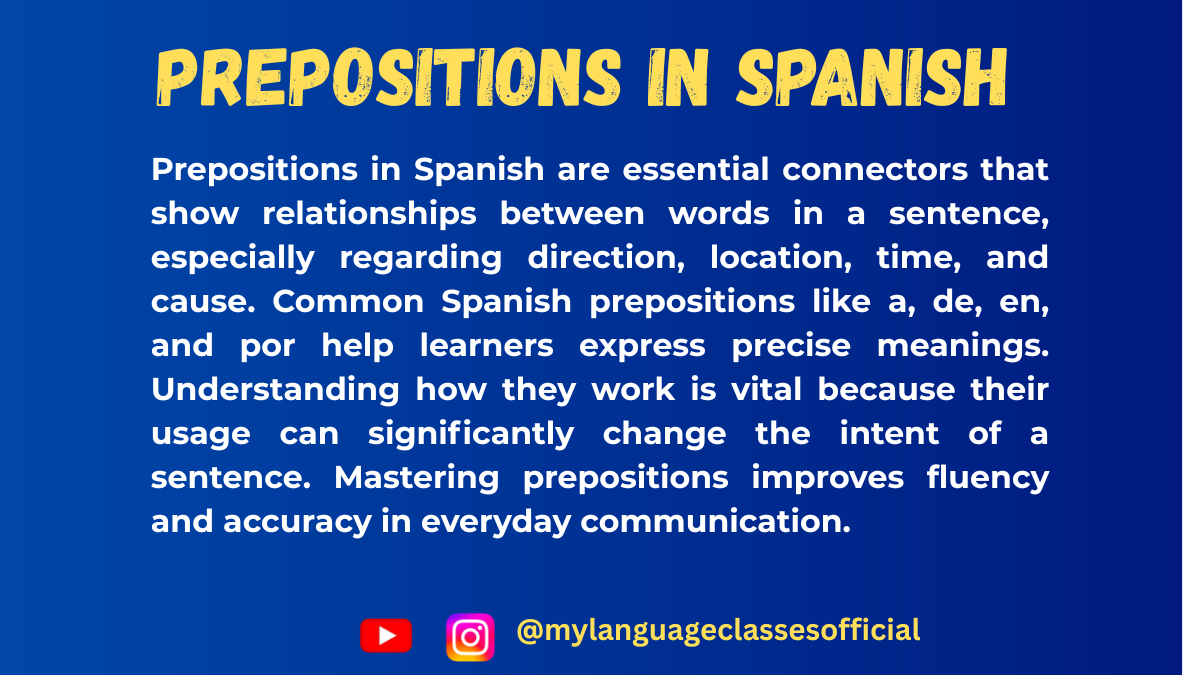
Mastering Prepositions in Spanish
Learning Spanish prepositions can seem tricky at first, but they’re essential for mastering the language. Prepositions are words that establish relationships between elements in a sentence, such as place, time, or cause. In this post, we’ll explore prepositions of place, prepositions of time, and other key types of prepositions in Spanish, with practical examples to enhance your understanding.
1. Prepositions of Place (Preposiciones de lugar)
Prepositions of place indicate the location of an object or person in relation to another. These are some of the most common:
Preposition Meaning Example en in/on/at El libro está en la mesa. (The book is on the table.) sobre on/above La lámpara está sobre la cama. (The lamp is above the bed.) bajo under/below El gato está bajo la silla. (The cat is under the chair.) entre between/among La tienda está entre el banco y la farmacia. (The store is between the bank and the pharmacy.) al lado de next to Mi casa está al lado de la escuela. (My house is next to the school.) frente a in front of El coche está frente a la casa. (The car is in front of the house.) Common Pitfall:
Learners often confuse en (in/on/at) with a (to/at). Remember:
- En emphasizes location (Estoy en casa = “I am at home”).
- A indicates motion or direction (Voy a casa = “I’m going home”).
2. Prepositions of Time (Preposiciones de tiempo)
Prepositions of time indicate when something happens. Here are key examples:
Preposition Meaning Example a at Nos vemos a las cinco. (We’ll see each other at five.) en in/on Nací en marzo. (I was born in March.) desde since/from Trabajo aquí desde 2018. (I’ve worked here since 2018.) hasta until Estaré aquí hasta las tres. (I’ll be here until three.) durante during Fuimos a España durante las vacaciones. (We went to Spain during the holidays.) Note:
The prepositions a and en often cause confusion when talking about time. For instance:
- Use a to refer to specific hours (a las siete = “at seven”).
- Use en for months, years, or periods (en abril = “in April”).
3. Other Common Prepositions
Beyond place and time, prepositions convey various relationships like cause, manner, or possession.
Preposition Meaning Example de of/from/about La casa de Juan es grande. (Juan’s house is big.) por for/because of/by Gracias por tu ayuda. (Thank you for your help.) para for/to/in order to Este regalo es para ti. (This gift is for you.) con with Voy al cine con mis amigos. (I’m going to the movies with my friends.) sin without No salgas sin paraguas. (Don’t go out without an umbrella.) Por vs. Para:
- Por often indicates a reason or means (Lo hice por amor = “I did it out of love”).
- Para suggests purpose or destination (Lo hice para ti = “I did it for you”).
4. How to Master Spanish Prepositions
- Practice with Context: Prepositions often don’t translate directly, so practice them within phrases.
- Memorize with Mnemonics: Use memory aids for tricky pairs like por and para.
- Engage in Real-Life Usage: Try journaling, speaking, or chatting with native speakers to reinforce prepositional phrases.
- Use Visual Aids: Draw diagrams to represent relationships like location (sobre = above, bajo = below).
Conclusion
Understanding and using prepositions correctly is a vital step in becoming fluent in Spanish. While their nuances may seem challenging, consistent practice and exposure will make them second nature. Whether you’re talking about the book on the table (sobre la mesa) or planning a meeting at five (a las cinco), prepositions allow you to express complex ideas with precision.
What are your biggest challenges with Spanish prepositions? Share your experiences in the comments! Let’s learn together. 😊
If you enjoyed this lesson, be sure to check out more posts like this on my blog at My Language Classes. Don’t forget to subscribe my YouTube channel and follow me on Instagram for the latest language learning tips and lessons. Leave a comment below to share your thoughts, or ask any questions you have.
Happy learning! 😊
-
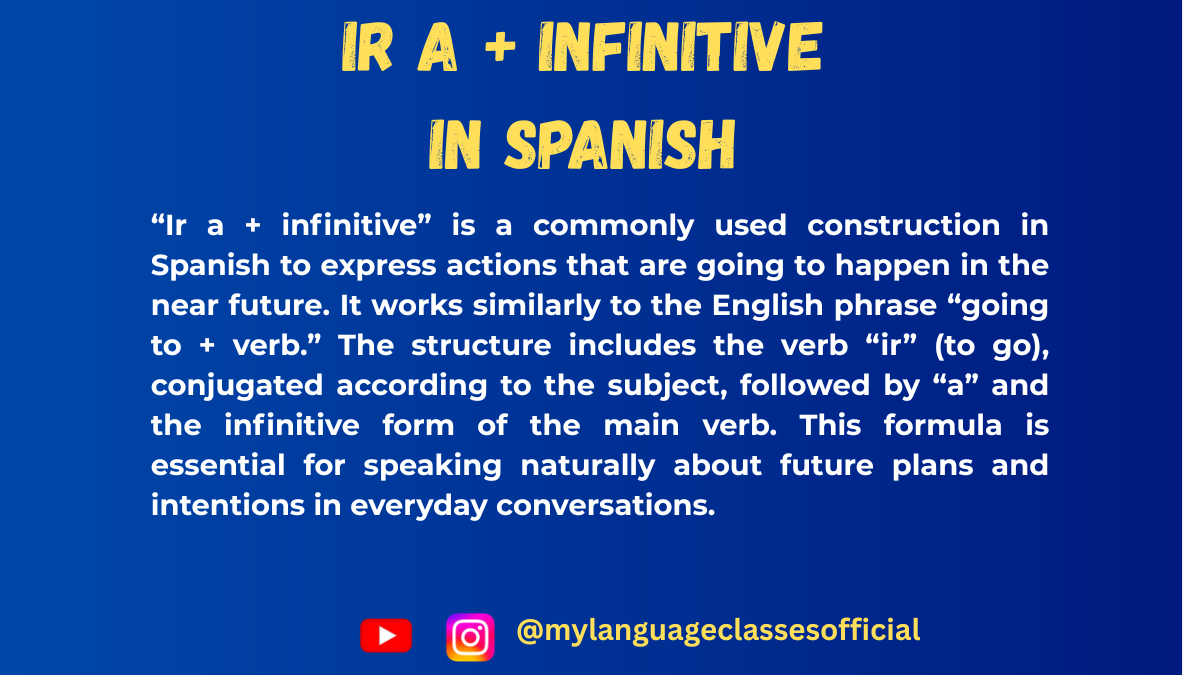
Near Future Tense in Spanish: Mastering Ir a + Infinitive
If you’re learning Spanish, you’ve likely encountered the phrase voy a estudiar (“I’m going to study”). This construction is an example of the near future tense, a simple and versatile way to talk about events that are going to happen soon. Today, we’ll explore how to use this tense, why it’s so practical, and how it compares to other future forms in Spanish. Let’s dive in!
What is the Near Future Tense?
The near future tense in Spanish uses the verb ir (to go), followed by the preposition a and an infinitive verb. It’s similar to the English construction “to be going to + verb.” For example:
- Voy a bailar. – I’m going to dance.
- Vamos a comer. – We’re going to eat.
- Ellos van a viajar. – They’re going to travel.
This structure is widely used in everyday conversation because it’s straightforward and easy to learn.
How to Form the Near Future Tense
The formula is simple:
[Conjugated form of ir] + a + [infinitive verb]Here’s how you conjugate ir in the present tense:
Subject Pronoun Conjugation of ir Yo voy Tú vas Él/Ella/Usted va Nosotros/as vamos Vosotros/as vais Ellos/Ellas/Ustedes van Once you’ve got ir conjugated, just add a and any infinitive verb:
- Voy a leer. – I’m going to read.
- ¿Vas a escribir? – Are you going to write?
- Ellos van a salir. – They are going to go out.
Why Use the Near Future Tense?
The ir a + infinitive construction is perfect for beginners because it’s less complicated than the simple future tense (hablaré, comerás, vivirán). It’s also highly practical—it allows you to talk about immediate plans or intentions without needing to learn additional verb conjugations.
For example:
- Instead of saying Estudiaré mañana (I will study tomorrow), you can say Voy a estudiar mañana (I’m going to study tomorrow).
- Both are correct, but voy a estudiar feels more conversational and is commonly used in informal settings.
Examples of Near Future in Everyday Situations
- Making Plans
- ¿Qué vas a hacer esta tarde? – What are you going to do this afternoon?
- Voy a ir al cine. – I’m going to go to the movies.
- Expressing Intentions
- Vamos a aprender mucho hoy. – We’re going to learn a lot today.
- Voy a ayudar a mi mamá. – I’m going to help my mom.
- Asking Questions
- ¿Vas a venir a la fiesta? – Are you going to come to the party?
- ¿Van a preparar la cena? – Are they going to prepare dinner?
Tips for Mastering the Near Future Tense
- Practice with Everyday Activities: Make a list of what you’re planning to do tomorrow and describe it using ir a + infinitive. For example, Voy a trabajar. Voy a estudiar. Voy a descansar.
- Combine with Time Expressions: Adding time markers helps specify when the action will happen. For example:
- Voy a salir mañana. – I’m going to go out tomorrow.
- Vamos a viajar en verano. – We’re going to travel in summer.
- Roleplay Common Scenarios: Imagine planning a weekend trip, a day at work, or a family gathering. Use phrases like Voy a comprar comida (I’m going to buy food) or Vamos a visitar a nuestros amigos (We’re going to visit our friends).
Comparison with the Simple Future
While the ir a + infinitive construction is easy and practical, the simple future tense (-é, -ás, -á, -emos, -éis, -án) is also important to learn for more formal or distant future events. For example:
- Voy a estudiar español. – I’m going to study Spanish (soon or in the near future).
- Estudiaré español en la universidad. – I will study Spanish at university (a more formal or distant future).
Conclusion
The ir a + infinitive construction is an essential tool for Spanish learners. It’s simple, flexible, and widely used in real-life conversations. By mastering this tense, you’ll be able to express your plans and intentions with confidence.
So, what are you going to do next? (¿Qué vas a hacer ahora?) Practice using this tense, and you’ll see how quickly it becomes a natural part of your Spanish conversations.
¡Buena suerte! 📝
If you enjoyed this lesson, be sure to check out more posts like this on my blog at My Language Classes. Don’t forget to subscribe my YouTube channel and follow me on Instagram for the latest language learning tips and lessons. Leave a comment below to share your thoughts, or ask any questions you have.
Happy learning! 😊
-

Learn How to Use Gustar and Similar Spanish Verbs
When learning Spanish, one of the trickiest yet most fascinating parts of the language is understanding how verbs like gustar work. These verbs don’t follow the typical subject-verb-object structure we’re used to in English. Instead, they flip the script—placing the person or thing we like (or love, or find interesting) at the forefront of the sentence. In this blog post, we’ll break down gustar and similar verbs like encantar and interesar so you can use them like a native speaker.
Understanding the Structure of Gustar
Let’s start with the basics. The verb gustar translates to “to like,” but it literally means “to be pleasing to.” This difference in meaning is key to mastering it. Here’s how it works:
- Indirect object pronoun + verb + subject.
- Me gusta el chocolate. (Chocolate is pleasing to me.)
- Nos gustan los libros. (The books are pleasing to us.)
- El libro me gusta. (singular)
- Los libros me gustan. (plural)
Indirect Object Pronouns
The indirect object pronouns are essential in these constructions because they indicate to whom something is pleasing:
Pronoun English Equivalent Me To me Te To you (informal) Le To him/her/you (formal) Nos To us Os To you all (informal, Spain) Les To them/you all For example:
- Te gusta bailar. (Dancing is pleasing to you.)
- Les gustan las películas. (The movies are pleasing to them.)
Expanding Beyond Gustar: Encantar and Interesar
Now that you’ve got the hang of gustar, you can easily apply this structure to similar verbs like encantar (to love), interesar (to be interested in), and others.
Encantar (To Love)
Use encantar to express stronger emotions, like loving something (but not romantically):
- Me encanta la música clásica. (I love classical music.)
- ¿Te encantan los animales? (Do you love animals?)
Interesar (To Be Interested In)
Use interesar to talk about interests or curiosities:
- Nos interesa la historia. (We are interested in history.)
- ¿Te interesan los deportes? (Are you interested in sports?)
Other Verbs Like Gustar
Here’s a quick list of other verbs that follow the same pattern:
- Fascinar: to fascinate
- Le fascinan los aviones. (Airplanes fascinate him/her.)
- Molestar: to bother
- Nos molesta el ruido. (The noise bothers us.)
- Importar: to matter, to be important
- ¿Te importa si abro la ventana? (Do you mind if I open the window?)
- Quedar: to have left
- Me quedan cinco dólares. (I have five dollars left.)
Common Mistakes to Avoid
- Using the wrong pronoun: Always match the indirect object pronoun with the person who feels the emotion, not the subject.
- Incorrect: Yo gusto los perros. (This means I am pleasing to dogs.)
- Correct: Me gustan los perros. (I like dogs.)
- Forgetting verb agreement: Make sure the verb matches the subject in number.
- Incorrect: Me gusta los libros.
- Correct: Me gustan los libros. (I like the books.)
- Literal translations: Remember, gustar doesn’t mean “to like” in a direct way. Think of it as “to be pleasing to” to grasp the Spanish logic.
Practice Makes Perfect
Here are some sentences for you to practice. Fill in the blanks with the correct form of the verb and pronoun:
- A mí _______ (encantar) las flores en primavera.
- ¿A ti _______ (interesar) el arte moderno?
- A ellos no _______ (gustar) la comida picante.
- A nosotros _______ (molestar) el ruido de la calle.
Final Thoughts
Verbs like gustar give Spanish its charm and unique flair. By understanding their structure and practicing regularly, you’ll unlock a whole new way of expressing yourself. Don’t be afraid to make mistakes—language learning is all about experimenting. ¡Buena suerte!
What’s your favorite gustar-style verb? Share your examples in the comments below!
If you enjoyed this lesson, be sure to check out more posts like this on my blog at My Language Classes. Don’t forget to subscribe my YouTube channel and follow me on Instagram for the latest language learning tips and lessons. Leave a comment below to share your thoughts, or ask any questions you have.
Happy learning! 😊
- Indirect object pronoun + verb + subject.
-
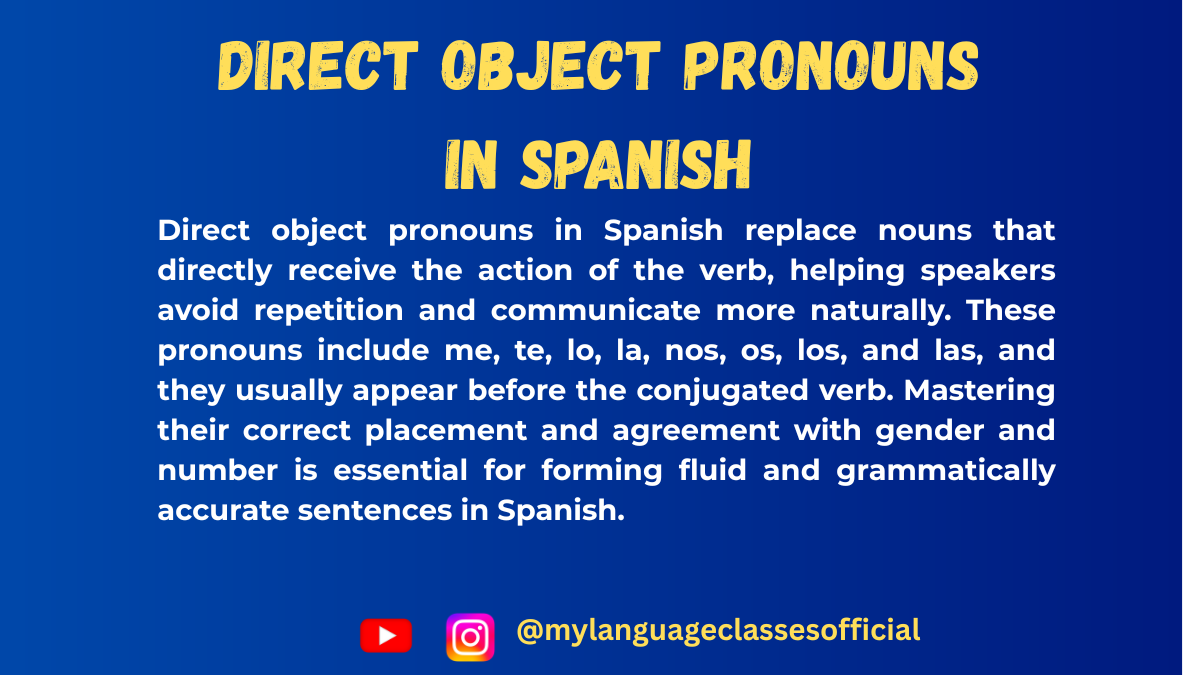
Mastering Direct Object Pronouns in Spanish
When learning Spanish, one of the most essential skills is understanding how to use direct object pronouns. These little words can simplify your sentences and make your speech sound more fluid and natural. In this blog, we’ll explore what direct object pronouns are, how they’re used, and provide plenty of examples to help you master them.
What Are Direct Object Pronouns?
A direct object in a sentence answers the questions “what?” or “whom?” about the verb. For example:
- I see the book. (What do I see? The book.)
- She calls her friend. (Whom does she call? Her friend.)
In Spanish, instead of repeating the noun (like “the book” or “her friend”), we replace it with a direct object pronoun.
The Direct Object Pronouns in Spanish
Here’s a handy table of direct object pronouns:
Pronoun English Meaning Me Me Te You (informal) Lo Him/It (masculine) La Her/It (feminine) Nos Us Os You all (informal, Spain) Los Them (masculine/mixed) Las Them (feminine)
Placement of Direct Object Pronouns
In Spanish, the placement of direct object pronouns can seem tricky at first, but there are clear rules:
- Before a Conjugated Verb
- Example:
- Yo veo el carro. (I see the car.) → Yo lo veo. (I see it.)
- Ella compra las flores. (She buys the flowers.) → Ella las compra. (She buys them.)
- Example:
- Attached to an Infinitive
- Example:
- Voy a llamar a María. (I am going to call María.) → Voy a llamarla. (I am going to call her.)
- Example:
- Attached to a Present Participle
- Example:
- Estoy leyendo el libro. (I am reading the book.) → Estoy leyéndolo. (I am reading it.)
- Note: Add an accent to maintain proper stress when attaching the pronoun.
- Example:
- Attached to an Affirmative Command
- Example:
- Compra el pan. (Buy the bread.) → Cómpralo. (Buy it.)
- Note: Add an accent when necessary to preserve the original stress.
- Example:
Examples in Action
Here are some real-life scenarios where direct object pronouns are used:
Simple Sentences
- ¿Tienes el dinero? (Do you have the money?)
→ Sí, lo tengo. (Yes, I have it.) - ¿Conoces a Ana? (Do you know Ana?)
→ Sí, la conozco. (Yes, I know her.)
Questions and Negatives
- ¿Estás mirando la televisión? (Are you watching the TV?)
→ No, no la estoy mirando. (No, I’m not watching it.)
Infinitives
- ¿Vas a ver la película? (Are you going to watch the movie?)
→ Sí, voy a verla. (Yes, I’m going to watch it.)
Commands
- Escribe la carta. (Write the letter.)
→ Escríbela. (Write it.)
Common Errors to Avoid
- Confusing Direct and Indirect Object Pronouns
Remember, direct object pronouns answer “what?” or “whom?”, while indirect object pronouns answer “to whom?” or “for whom?”Example:- Direct: Lo veo. (I see him.)
- Indirect: Le hablo. (I speak to him.)
- Forgetting to Match Gender and Number
Make sure the pronoun matches the noun in gender and number. For example:- Las cartas (the letters) → las
- El carro (the car) → lo
- Misplacing Pronouns
Incorrect: Voy llamarla.
Correct: Voy a llamarla or La voy a llamar.
Practice Time!
Let’s put your skills to the test. Try replacing the direct object with a pronoun in the following sentences:
- Yo compro las manzanas.
- Nosotros vemos a Juan.
- María está leyendo el libro.
- ¿Has visto a tus amigos?
- Compra los billetes.
Answers
- Yo las compro.
- Nosotros lo vemos.
- María está leyéndolo.
- ¿Los has visto?
- Cómpralos.
Final Thoughts
Direct object pronouns are a powerful tool to make your Spanish more efficient and natural. With practice, using them will become second nature. Start incorporating them into your conversations today—you’ve got this!
Keep practicing, and soon you’ll sound like a native! 😊
If you enjoyed this lesson, be sure to check out more posts like this on my blog at My Language Classes. Don’t forget to subscribe my YouTube channel and follow me on Instagram for the latest language learning tips and lessons. Leave a comment below to share your thoughts, or ask any questions you have.
Happy learning! 😊
-
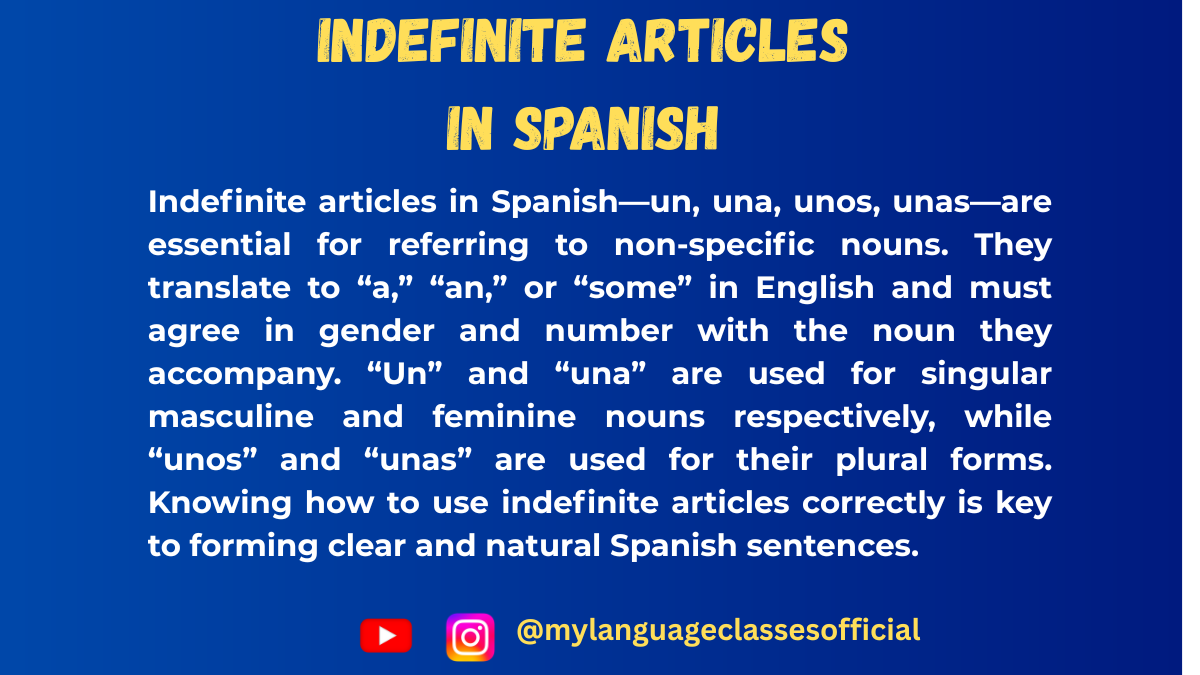
Understanding Spanish Indefinite Articles: A Complete, Easy Guide for Beginners
Learning Spanish can be a fun and exciting journey, especially when you learn how to use small words that make a big difference. One of the most important parts of Spanish grammar is the use of indefinite articles. These little words—un, una, unos, unas—help you talk about people, objects, and ideas without being too specific. This complete guide will help you understand how these words work and will provide many examples, exercises, and tips to build your confidence. Whether you are just starting out or looking to improve your Spanish, this guide is designed to be friendly and easy to understand!
What Are Indefinite Articles?
Indefinite articles are words that refer to an object or person in a general way. In Spanish, these words help to introduce something new into a conversation without pointing to a particular item. For instance, when you say “I saw a dog,” you are not talking about a specific dog that everyone knows, but rather any dog you might see.
- Indefinite articles in Spanish include:
- Un (for masculine singular nouns)
- Una (for feminine singular nouns)
- Unos (for masculine plural nouns)
- Unas (for feminine plural nouns)
These words are like little building blocks that help you construct sentences, allowing you to introduce new ideas in a clear and friendly way.
The Role of Indefinite Articles in Spanish
Indefinite articles play a crucial role by giving your sentences a smooth and natural flow. They are similar to the words “a,” “an,” and “some” in English. Here are a few ways these articles help in everyday conversation:
- Introducing New Items:
Use an indefinite article when mentioning something for the first time. - Describing Quantities:
They help express unspecific amounts, like “some” or “a few.” - Giving Approximate Numbers:
They can be used to say “about” or “around” when numbers are not exact.
By using these articles correctly, your sentences will sound more natural and easy to understand. For example, saying “I have a book” introduces the idea of a book without pointing to a specific one, unlike “I have the book,” which refers to a particular book known to both the speaker and the listener.
How to Use Singular Indefinite Articles
When speaking Spanish, it is important to choose the right article based on the gender and number of the noun. Let’s explore the two singular forms:
Un (Masculine)
The word “un” is used before masculine singular nouns. Use this article when you are talking about one object or person that is not specific.
- Example Sentence:
- Spanish: Quiero un libro.
- English Translation: I want a book.
- Another Example:
- Spanish: Veo un perro en la calle.
- English Translation: I see a dog on the street.
Even if some nouns seem to have a feminine ending in certain cases, remember to check the correct gender. There are exceptions, and with practice, you will remember them easily.
Una (Feminine)
The word “una” is used before feminine singular nouns. This form helps when you want to talk about one female object or person.
- Example Sentence:
- Spanish: Ella necesita una silla.
- English Translation: She needs a chair.
- Another Example:
- Spanish: Voy a comprar una manzana.
- English Translation: I am going to buy an apple.
Note: Sometimes there are tricky words. For example, although many words ending in -a are feminine, some exceptions exist like “mano” (hand), which is feminine despite its appearance.
How to Use Plural Indefinite Articles
When talking about more than one object or person, you will need to use the plural forms. The plural articles in Spanish are “unos” and “unas.”
Unos (Masculine)
The word “unos” is used for masculine plural nouns. It is often used in situations where you want to say “some” when talking about more than one masculine object or person.
- Example Sentence:
- Spanish: Compré unos zapatos nuevos.
- English Translation: I bought some new shoes.
- Another Example:
- Spanish: Hay unos niños jugando en el parque.
- English Translation: There are some children playing in the park.
Unas (Feminine)
The word “unas” is used for feminine plural nouns. It is the counterpart to “unos” and is used when referring to several feminine objects or persons.
- Example Sentence:
- Spanish: Tengo unas amigas muy simpáticas.
- English Translation: I have some very nice friends.
- Another Example:
- Spanish: Vimos unas estrellas brillantes anoche.
- English Translation: We saw some bright stars last night.
When to Use and When to Omit Indefinite Articles
Knowing when to use an indefinite article and when to leave it out is an important skill that comes with practice. Here are some key points:
When to Use Indefinite Articles
- Introducing Something New:
Use an indefinite article when mentioning something for the first time in a conversation.- Example: Tengo un coche nuevo.
(I have a new car.)
- Example: Tengo un coche nuevo.
- Describing Unspecified Quantities:
Use them when you do not need to mention an exact number or identity.- Example: Unos estudiantes llegaron tarde.
(Some students arrived late.)
- Example: Unos estudiantes llegaron tarde.
- Expressing Approximation:
They can be used to show that a number is approximate.- Example: Había unas diez personas en la reunión.
(There were about ten people at the meeting.)
- Example: Había unas diez personas en la reunión.
When to Omit Indefinite Articles
Sometimes, Spanish speakers leave out the indefinite article in certain constructions:
- After the Verb “Ser” (To Be):
When talking about professions, nationalities, or general descriptions, the article is often omitted.- Example: Soy médico.
(I am a doctor.) - Example: Ella es española.
(She is Spanish.)
- Example: Soy médico.
- Before Plural Nouns in General Statements:
When speaking about things in general, the article is usually not needed.- Example: Tengo libros en casa.
(I have books at home.) - Example: Vimos flores en el jardín.
(We saw flowers in the garden.)
- Example: Tengo libros en casa.
Understanding these rules and exceptions will help your Spanish sound natural and fluent.
Tips to Remember
Here are some quick and friendly tips to help you master indefinite articles in Spanish:
- Know the Gender:
Every noun in Spanish has a gender. This will help you choose between “un” and “una” for singular, and “unos” and “unas” for plural. - Practice Changing Forms:
Try changing sentences from singular to plural. For example, change “un gato” to “unos gatos” and observe how the sentence changes. - Listen to Native Speakers:
Listening to songs, watching movies, or having conversations in Spanish will help you hear these articles used naturally. - Read and Write Regularly:
Reading Spanish stories or writing short paragraphs will give you more practice and make these rules feel more natural. - Be Patient and Keep Practicing:
Learning a new language takes time. Celebrate small victories, like correctly using an indefinite article in a conversation, as each step brings you closer to fluency.
Example Sentences
Let’s look at some detailed example sentences that include both the Spanish sentence and its English translation. These examples show you how to use indefinite articles naturally in different contexts.
Example 1: Singular Masculine
- Spanish: Quiero un libro interesante.
- English: I want an interesting book.
This sentence shows the use of “un” with the masculine noun “libro” (book).
Example 2: Singular Feminine
- Spanish: Necesito una bicicleta nueva.
- English: I need a new bicycle.
Here, “una” is used with “bicicleta”, a feminine noun.
Example 3: Plural Masculine
- Spanish: Compré unos lápices de colores para la clase.
- English: I bought some colored pencils for the class.
This example uses “unos” with “lápices”, which is masculine and plural.
Example 4: Plural Feminine
- Spanish: Encontré unas flores bonitas en el jardín.
- English: I found some pretty flowers in the garden.
The word “unas” is used with “flores”, a feminine plural noun.
Example 5: Introducing a New Idea
- Spanish: Hoy tengo un anuncio importante que hacer.
- English: Today I have an important announcement to make.
This sentence is a great example of using an indefinite article to introduce something new.
Example 6: Expressing an Approximate Quantity
- Spanish: Había unas cinco personas en la reunión.
- English: There were about five people at the meeting.
This shows how indefinite articles can express an approximate number.
Exercise
Now it is time to put what you have learned into practice. Complete the following exercises and check if you are using the correct forms of indefinite articles.
Fill in the Blanks
- Sentence: Quiero ___ silla para mi escritorio.
Hint: Use the feminine singular form. - Sentence: Compré ___ manzanas en el mercado.
Hint: Use the feminine plural form. - Sentence: Veo ___ pájaro en el árbol.
Hint: Use the masculine singular form. - Sentence: Hay ___ perros en el parque.
Hint: Use the masculine plural form.
Translate to Spanish
- English: I see a girl.
Hint: Use the feminine singular form. - English: Some dogs are barking.
Hint: Use the masculine plural form. - English: She needs a computer.
Hint: Use the feminine singular form. - English: I bought some books.
Hint: Use the masculine plural form.
Take your time with these exercises. Practice is the best way to become confident in using Spanish correctly.
Summary
Here are the key points to remember from this guide:
- Indefinite articles in Spanish help introduce non-specific nouns.
- Singular Forms:
- Un: Used with masculine singular nouns.
- Una: Used with feminine singular nouns.
- Plural Forms:
- Unos: Used with masculine plural nouns.
- Unas: Used with feminine plural nouns.
- Usage Tips:
- Use articles when introducing something for the first time.
- Use them to describe unspecific amounts.
- Omit them in specific cases, such as after the verb “ser” for professions or nationalities.
- Practice Tips:
- Listen to native speakers.
- Read and write regularly.
- Practice switching between singular and plural forms.
- Exercises and Examples:
- Completing fill-in-the-blank exercises helps reinforce learning.
- Translating simple sentences builds confidence.
Conclusion
Mastering Spanish grammar is a rewarding process, and understanding indefinite articles is an important step in that journey. By learning how to use un, una, unos, and unas, you build a strong foundation for everyday conversation. With plenty of examples, clear explanations, and helpful exercises, you are well on your way to speaking Spanish naturally.
Keep practicing with simple sentences, listen carefully to how others use these words, and always try to speak as much as you can. Every great speaker started as a beginner, and each small success brings you closer to fluency. Stay curious, enjoy the process, and celebrate your progress as you continue learning the beautiful Spanish language.
If you enjoyed this lesson, be sure to check out more posts like this on my blog at My Language Classes. Don’t forget to subscribe my YouTube channel and follow me on Instagram for the latest language learning tips and lessons. Leave a comment below to share your thoughts, or ask any questions you have.
Happy learning! 😊
- Indefinite articles in Spanish include:

